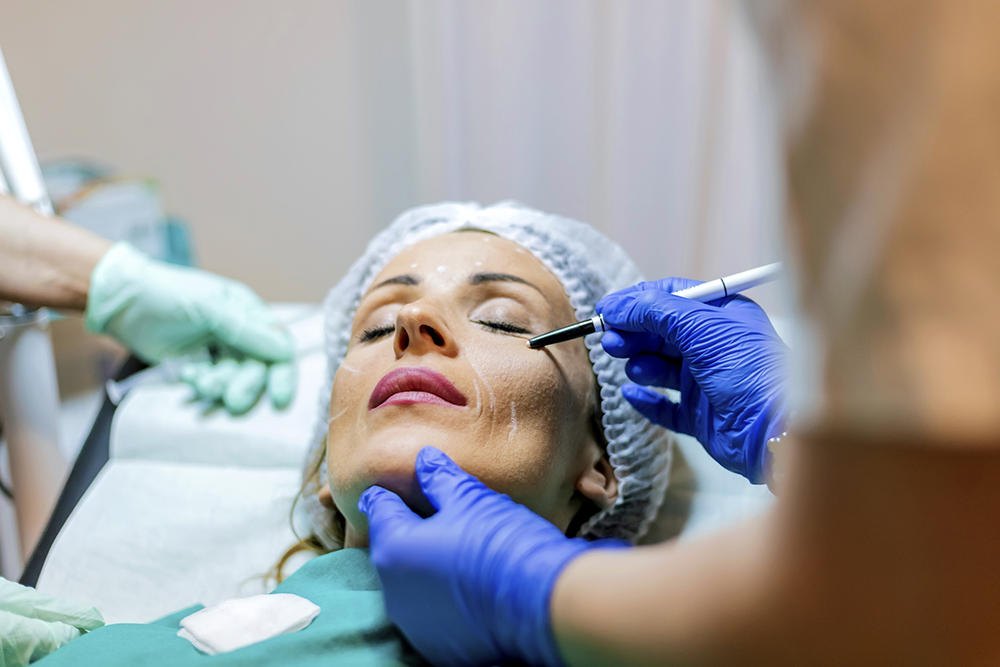Facelift in Phoenix, Arizona
Is a Facelift Right for Me?
The facelift procedure continues to evolve. Over the years, the procedure has changed from simple skin lifting to more complex deeper plane techniques. Today, many different techniques exist, with outcomes that are consistently reliable and durable. As a talented board-certified plastic surgeon, Dr. Larry C. Leverett offers several facelift procedures that he carefully customizes according to the aesthetic needs of each patient in Ahwatukee, Chandler, Gilbert and the surrounding communities of Phoenix.
What Is a Facelift?
A facelift is a cosmetic surgery procedure aimed at improving visible signs of aging in the face and neck. The surgery involves the removal of excess facial skin, tightening of underlying tissues, and the redraping of skin on the face and neck. It can address sagging skin, deep folds, jowls, and fat displacement, offering a more youthful and refreshed appearance.
What Are The Benefits Of A Facelift?
People undergo facelifts to appear younger by erasing signs of aging. Some of the benefits of a facelift include:
- Diminishes fine lines and wrinkles, creating a more youthful appearance
- Tightens facial muscles to eliminate sagging skin
- Boosts self-confidence
- Improves facial tone
- Restores a positive self-image
Patient Reviews
"Candyce at Body by Levertte is amazing! She is very knowledgeable and honest with what your skin needs. No trying to sell products, just providing a relaxing facial while also educating you on a good face care routine. I highly recommend goi g to see Candyce." - Jaclyn P.
Patient Before & Afters
Facelift Case 13
Browlift, Face lift, Lower Blephroplasty, Mole Removal
51yo
Facelift Case 1
Secondary Facelift 68yo
Questions For Your Consult
Am I A Good Candidate For A Facelift?
Ideal candidates for a facelift are those who have noticeable facial aging but still have some skin elasticity, are in good overall health, do not smoke, and have realistic expectations about the outcome. Age is not a definitive criterion; rather, the presence of skin laxity and facial aging signs determines candidacy. A clearance from your healthcare provider is required to proceed with surgery. Patients who are currently smoking must discontinue the use of any nicotine products (that includes gum and the patch) three months prior to surgery. The best way to determine your candidacy is to schedule a consultation with Dr. Leverett, where you can discuss your cosmetic goals and determine if a facelift is a good fit for you.
What is the Best Age for a Facelift?
There is no "best" age for a facelift as individuals age differently based on genetics, lifestyle, and environmental factors. Some patients begin seeing the signs of aging around their neck, jowls and smile lines earlier than expected, and the non-surgical procedures are not enough of a correction for them. Therefore, patients may look at undergoing a facelift surgery as young as 40 years old and up to 80 years old. It is not uncommon for a patient who had a facelift earlier in life to undergo a secondary facelift as the aging process continues to affect their appearance. Ultimately, if you are unable to achieve your cosmetic goals without surgery, you may be a good candidate for a facelift regardless of your age.
How Much Does A Facelift Cost?
The cost of your facelift procedure will vary depending on the extent of surgery needed to produce your desired results, and any other customizations made to your surgical approach. During your consultation Dr. Leverett and his staff will discuss the costs associated with your personalized treatment plan. To help make facelift surgeries more affordable and accessible to his patients, Dr. Leverett offers financing through CareCredit® and Prosper Healthcare Lending. Our office also accepts Visa, MasterCard, American Express, Discover, cash and cashier’s checks.

What is Facelift Surgery Like?
What Happens During Facelift Surgery?
The facelift procedure frequently involves incisions around the ears and depending on the patient may extend into the scalp. Once the incisions are made, the skin is gently elevated, and the deeper layers of the face are lifted or suspended. Muscle tightening, as well as liposuction of the neck and jowls, may be performed, and excess skin is either removed or repositioned. The procedure is often done on an outpatient basis and in some cases is done under IV sedation. The results are a softening of the unwelcome effects of gravity and a more youthful contour to the face and neck
What Do Facelift Scars Look Like?
Facelift scars are carefully placed in natural skin creases or areas where they can be hidden by the hairline or the natural contours of the ear, making them less noticeable. Over time, these scars will fade significantly, although they will not disappear entirely. Dr. Leverett makes every effort to eliminate visible scarring, and will provide you with post-care instructions that will help your incisions heal with as little scarring as possible.
What is Facelift Recovery Like?
How Long Does It Take To Recover From A Facelift?
Many patients are pleasantly surprised at how quickly the recovery process is. We do advise patients to take two weeks off from work and social events, as there is bruising and swelling following the procedure. We have patients begin anti-bruising remedies prior to surgery and topical treatments after to help reduce the bruising. Swelling is typically gone in seven to 10 days. During the first two weeks following surgery, you will have scheduled visits in our office for dressing and suture removal.
How Painful Is Recovery From A Facelift?
Post-operative discomfort is typically mild to moderate and can be managed with prescribed pain medication. However, most patients are pleasantly surprised to discover that the pain following a facelift is less than expected, and begins to decrease significantly within the first few days after surgery.

Still, pain management is a critical aspect of recovery. Dr. Leverett will prescribe pain medication to help manage any discomfort, and many patients find they can transition to over-the-counter pain relievers within a few days to a week. It's important to follow Dr. Leverett's guidance on medication to ensure you're managing pain effectively while also supporting your body's healing process. Cooling packs can also be used to help reduce swelling and numb the discomfort, but they should be used as directed to avoid reducing blood flow to the healing tissues.
How to Speed Up Facelift Recovery
Accelerating the recovery process after a facelift involves a combination of following post-operative instructions meticulously and taking proactive steps to support your body's natural healing processes. By carefully following these guidelines, you can help ensure a smoother, quicker facelift recovery:
- Strictly Adhere to Post-Operative Instructions: Dr. Leverett will provide detailed care instructions tailored to your specific procedure. These may include how to care for your incisions, when to return for follow-up appointments, and how to use any prescribed medications. Following these instructions is crucial for minimizing complications and speeding up recovery.
- Keep Your Head Elevated: Maintaining an elevated head position, even during sleep, for at least the first 2 weeks post-surgery can significantly reduce swelling and accelerate healing.
- Avoid Strenuous Activities: Physical exertion can increase blood pressure and lead to bleeding, swelling, and delayed healing. Avoid heavy lifting, vigorous exercise, and other strenuous activities as advised by Dr. Leverett.
- No Smoking: Smoking restricts blood flow and can significantly delay healing, increasing the risk of complications. It's essential to abstain from smoking both before and after surgery for a period recommended by Dr. Leverett.
- Stay Hydrated and Maintain a Nutritious Diet: Proper hydration is vital for healing. Drinking plenty of water and consuming a balanced diet rich in vitamins and minerals can help speed up recovery. Foods high in vitamins A and C, protein, and zinc can support wound healing.
- Attend All Follow-Up Appointments: Post-operative appointments allow Dr. Leverett to monitor your healing and address any concerns promptly. These visits are essential for ensuring a smooth recovery and optimal outcomes.
- Manage Stress: Stress can impede healing, so finding ways to relax and maintain a positive outlook is important. Consider meditation, reading, or any other low-impact activity that helps you stay calm and centered.
Post Surgery Frequently Asked Questions
When Can I Sleep On My Side After a Facelift?
It's recommended to sleep with your head elevated and on your back for the first few weeks after surgery to minimize swelling and avoid putting pressure on the healing incisions. Sleeping on your side can be gradually resumed as instructed by Dr. Leverett, typically after the initial swelling has decreased. For most patients, this occurs approximately two to four weeks after surgery.
How Long Does a Facelift Last?
The results of a facelift can last for many years, with most patients enjoying the benefits for 10 years or more. The longevity of the results depends on several factors, including skin quality, lifestyle, and genetics. Adopting a healthy lifestyle, protecting your skin from the sun, and following a good skincare regimen can help extend the results. However, a facelift cannot pause the aging process. Your skin will continue to age over time. You can view the facelift as a way to “turn back the clock” several years and maintain a youthful appearance!
You only get to make a first impression once. Don’t let your impression be an old, tired, rundown one. If you live in or around the Greater Phoenix area, such as Ahwatukee, Chandler and Gilbert, please contact board-certified plastic surgeon Dr. Larry C. Leverett to schedule your facelift consultation. Dr. Leverett and the staff at Body By Leverett are committed to helping you reach your cosmetic goals.














